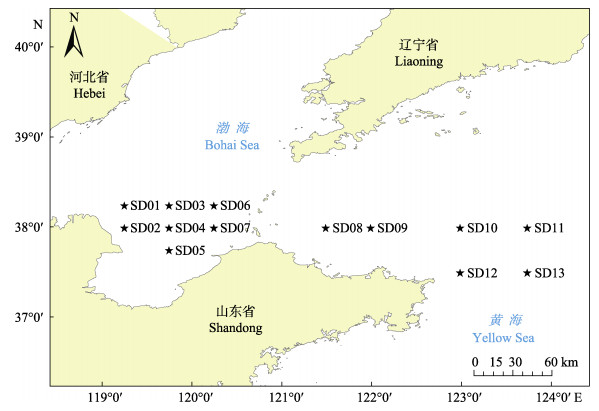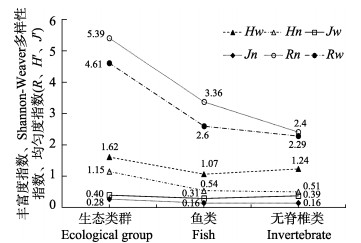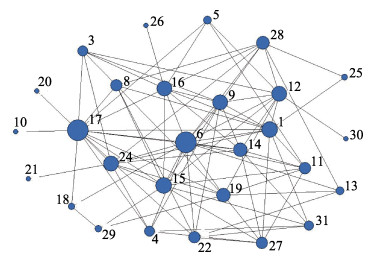2. 上海海洋大学海洋科学学院 上海 201306;
3. 山东长岛近海渔业资源国家野外科学观测研究站 山东 烟台 265800;
4. 山东省东营市垦利区海洋发展和渔业局 山东 东营 257091;
5. 山东省海洋资源与环境研究院 山东 烟台 264006
 (Lophius litulon)、鳀、小黄鱼(Larimichthys polyactis)和矛尾
(Lophius litulon)、鳀、小黄鱼(Larimichthys polyactis)和矛尾 虎鱼(Chaeturichthys stigmatias)。2021年春季渔业生物密度、鱼类密度和甲壳类密度健康指数均为健康状态,而头足类密度健康指数则处于亚健康状态。相比2011—2013年,多种经济种类密度有较大增长,山东半岛北部海域渔业生物健康状况总体良好。
虎鱼(Chaeturichthys stigmatias)。2021年春季渔业生物密度、鱼类密度和甲壳类密度健康指数均为健康状态,而头足类密度健康指数则处于亚健康状态。相比2011—2013年,多种经济种类密度有较大增长,山东半岛北部海域渔业生物健康状况总体良好。2. College of Marine Sciences, Shanghai Ocean University, Shanghai 201306, China;
3. National Field Observation and Research Center for Fisheries in Changdao Waters, Yantai 265800, China;
4. Kenli Municipal Bureau of Marine Development and Fisheries in Dongying, Dongying 257091, China;
5. Marine Resources and Environment Research Institute, Yantai 264006, China
山东海域具有丰富的陆源营养物质补充,基础生产力较高,具备适宜渔业生物生长和繁育的水动力基础和地质条件(金显仕等, 2005; 吕振波, 2010)。近年来,随着全球气候变暖和人类活动加剧,山东近海渔业资源普遍衰退、种类交替明显、渔获物小型化和低质化、物种多样性降低,重要渔业资源已不能形成渔汛,对黄渤海渔业资源的支持功能日益减退(金显仕, 2020; Jin et al, 2013)。对山东近海渔业生物的研究以山东半岛南部和近岸海域渔业生物群落结构和无脊椎动物为主(杨刚等, 2017; 吴强等, 2011; 唐启升等, 1990),对山东半岛北部海域渔业生物种类组成、群落结构和渔业生物健康评价研究较少。因此,本研究基于2021年5—6月“中渔科102”调查船在山东半岛北部海域的底拖网渔业资源调查数据,结合相关文献,分析该海域渔业生物种类组成、优势种和多样性,通过食物网拓扑结构与社会网络分析法,分析该海域渔业生物关键种,以2011和2013年调查数据为基准,分析该海域渔业生物健康状况,以期为山东半岛海域渔业资源养护和管理提供支撑。
1 材料与方法 1.1 数据来源数据来源于“中渔科102”调查船在山东半岛北部海域的底拖网渔业资源调查(图 1)。调查时间为2021年5—6月,调查海域为山东半岛北部海域(37°00ʹ~39°00ʹN, 119°00ʹ~124°00ʹE),网具参数:囊网网目20 mm,网口周长88 m,网长58 m。每站拖网时间为1 h,平均拖速为3.0 kn。本研究食性数据参考邓景耀等(1997)、韦晟等(1992)、杨纪明(2001)和张波(2018),并对摄食关系进行归纳整理。

|
图 1 山东半岛北部海域调查站位 Fig.1 Schematic diagram of survey stations in the waters off northern Shandong Peninsula |
群落结构分析方法见表 1。
|
|
表 1 群落结构分析指标 Tab.1 Related indicators of community structure analysis |
通过食物网拓扑结构建立一系列拓扑学指标,定量表示食物网中不同节点的位置关系及联系程度,根据拓扑结构指标确定该食物网中关键种,同时运用社会网络分析法,将食物网拓扑结构指标进一步量化,研究食物网的结构,进而监测生态群落的稳定性。本研究使用的指数包括点度(degree, D)、入度(Din)、出度(Dout)、中间中心性(betweenness centrality, BC)、紧密中心性(closeness centrality, CC)、信息中心性(information centrality, IC)、拓扑重要性指数(topological importance index, TI)、关键性指数(keystone index, K)、上行关键指数(bottom-up keystone index, Kb)、下行关键指数(top-down keystone, Kt)、群落离散度(fragmentation, F)、距离权重离散度(distance-weighted fragmentation, DF),以上指标具体计算公式及评价标准参考苏程程等(2021)。群落种间聚类系数计算参照Watts等(1998)。
1.2.3 渔业生物健康评价山东半岛北部海域渔业生物健康评价参考韩青鹏等(2022)。以2011年和2013年5月、6月的山东近海渔业生物健康状况作为基准(表 2),通过健康指数(HI)表征游泳动物质量状态。
| $ \mathrm{HI}=R $ |
|
|
表 2 山东近海渔业生物健康评价指标* Tab.2 Evaluation index of biological quality status of inshore fishery in northern Shandong Peninsula* |
式中,R为指标的重新赋值,将渔业生物健康状况分为5种状态:极不健康(0 < R≤0.2)、不健康(0.2 < R≤0.4)、亚健康(0.4 < R≤0.6)、较健康(0.6 < R≤0.8)和健康(0.8 < R≤1.0)。
1.3 统计分析Ucinet 6软件计算D、Dout、Din、BC、CC和IC,CoSBiLaB Graph 1.0软件计算TI1、TI7、K、Kb和Kt, Keypalyer 1.44软件计算F和DF,统计分析通过SPSS 20.0和Excel 2016。
2 结果 2.1 种类组成山东半岛北部海域调查共捕获鱼类31种,隶属于11目、24科、28属。从适温性看,暖水性8种,占25.8%;暖温性16种,占51.6%;冷温性7种,占22.6%。按栖息水层分,主要生活在底层和近底层的有24种,占77.42%;在中上层的有7种,占22.6%。从鱼类经济品质来看,经济价值较高的有12种,占38.7%;经济价值一般的有9种,占29.03%;经济价值较低的有10种,占32.25% (表 3)。
|
|
表 3 山东半岛北部海域渔业生物种类组成 Tab.3 Composition of inshore fishery organisms in northern Shandong Peninsula |
山东半岛北部海域共捕获无脊椎动物22种,其中,甲壳类16种,占72.7%;软体动物4种,占18.2%;棘皮动物2种,占9.1%。按经济价值的高低来分,经济价值较高的有7种,占31.8%;经济价值较低的是13种,占59.1%;无经济价值的为2种,占9.1%。
2.2 优势种山东半岛北部海域中,鳀(Engraulis japonicus)是鱼类中唯一的优势种,其捕获量在鱼类中占60.12%,另一优势种为甲壳类的脊腹褐虾(Crangon affinis),其捕获量占总渔获量13.6%;重要种有黄
|
|
表 4 山东半岛北部海域渔业生物优势度 Tab.4 Dominance of ecological group of inshore fishery in northern Shandong Peninsula |
山东半岛北部海域生物多样性呈现总优势度 > 鱼类 > 无脊椎动物类的趋势(图 2),鱼类物种丰富度指数(R)明显高于无脊椎动物类,而群落多样性指数(Hʹ)和物种均匀度指数(Jʹ)二者差异不十分显著。根据在1983—1985年、1998年、2006年调查数据(程济生, 2004; 吕振波, 2010)显示(表 5),2021年春季鱼类多样性指数和均匀度指数呈现下降的趋势,无脊椎动物均匀度2021年最低,鱼类和无脊椎动物丰富度指数高于1998年(表 5)。

|
图 2 2021年山东半岛北部海域渔业生物多样性变化 Fig.2 The biodiversity of inshore fishery in northern Shandong Peninsula in 2021 |
|
|
表 5 山东半岛北部海域渔业生物多样性变化 Tab.5 The changes of biodiversity of inshore fishery in northern Shandong Peninsula |
山东半岛北部海域鱼类食物网中包含物种数量(S)为28个,摄食关系数量(L)为94。食物网拓扑结构密度(Dd)为0.246,种间关联度(C)为0.1199,聚类系数(Cl)为0.2510,加权聚类系数(W–Cl)为0.281。
2021年春季共捕获鱼类31种,绿鳍马面鲀(Thamnaconus modestus)、大银鱼(Protosalanx hyalocranius)和银鲳与其他鱼类无摄食关系(邓景耀等, 1997; 韦晟等, 1992; 杨纪明, 2001; 张波, 2018),不纳入到食物网拓扑结构分析中,构建除此以外的28种鱼类的食物网拓扑结构(图 3)。

|
图 3 山东半岛北部海域鱼类群落食物网拓扑结构 Fig.3 Topological structure of fish community food-web of inshore in northern Shandong Peninsula |
根据表 6结果显示,山东半岛北部海域鳀和矛尾





|
|
表 6 2021年山东半岛北部海域春季鱼类群落拓扑结构指标 Tab.6 Spring fish community topology indicators of inshore in northern Shandong Peninsula in 2021 |
取各指标中最大值为关键种(Jordán et al, 2006), 确定细纹狮子鱼、矛尾

以2011年和2013年5月、6月的渔业资源调查各种类密度均值为基准,2021年5月游泳动物密度指标、鱼类密度指标和甲壳类密度指标健康指数均为健康状态,而头足类密度则处于亚健康状态。该海域重要经济鱼类中,鳀、银鲳、花鲈、鲆鲽类、小带鱼、大泷六线鱼、长蛇鲻等均处于健康状态,小黄鱼处于亚健康状态。头足类中,蛸类和枪乌贼(Loligo japonica)分别处于健康和不健康的状态。甲壳类虽处于健康状态,但口虾蛄处于极不健康的状态,脊腹褐虾占甲壳类密度的59%,拉高了甲壳类质量状况的评分(表 7)。
|
|
表 7 山东近海渔业生物健康指标 Tab.7 Evaluation index of biological quality status of inshore fishery in northern Shandong Peninsula |
与21世纪初春季相比(吕振波, 2010; 李涛, 2010; 杨涛等, 2016),2021年山东半岛北部海域渔获种类组成无明显差异,经济价值较高的种类所占比例较大(表 4)。渔获物各栖息水层的生物占比有明显变化,中上层鱼类所占比例降低(表 4),渤海其他海域出现相同变化(金显仕等, 2020)。1998年和2006年中上层鱼类占据超过40%至2021年仅占据22% (程济生, 2004; 吕振波, 2010),此次调查中,中上层鱼类主要为鳀、黄鲫(Setipinna taty)、青鳞小沙丁鱼(Sardinella zunasi)等小型种类。优势种的更替呈现中上层鱼类逐渐减少的趋势,1998年优势种为鳀、小黄鱼、黄鲫;2006年为鳀、玉筋鱼、方氏云鳚、斑

2021年山东半岛北部海域春季鱼类群落中,关键种为细纹狮子鱼、矛尾




黄





人类活动造成栖息地破碎化是影响渔业资源早期补充的环境因子(金显仕, 2020)。自20世纪70年代以来,山东近海渔业资源衰退,生物多样性降低(Jin et al, 2013; 金显仕等, 2005)。近30年变迁表明,渤海鱼卵、仔稚鱼种类数及资源丰度持续下降(卞晓东等, 2018)。21世纪初,山东省海洋渔业生态系统的健康状况总体呈现下降的趋势(孙吉亭, 2020),山东近海产卵场健康状况均处于亚健康状态(韩青鹏等, 2021)。本研究发现,山东半岛北部海域春季渔业生物密度、鱼类密度和甲壳类密度健康指数均为健康状态,而头足类密度健康指数则处于亚健康状态。相比2011—2013年,多种经济种类密度有较大的增长,山东半岛北部渔业动物状况总体良好,研究结果可为山东近海的渔业资源养护和管理提供参考,但渔业生物群落结构及其健康状况受多种因素的影响,需要长期的数据佐证,后期需进一步关注山东近海渔业生物健康状况及群落结构的变化,为山东近海渔业资源的精准管理提供技术支撑。
ARMSTRONG M P, MUSICK J A, COLVOCORESSES J A. Age, growth, and reproduction of the goosefish Lophius americanus (Pisces: Lophiiformes). Fishery Bulletin, 1992, 90(2): 217-230 |
BELGRANO A, SCHARLER U M, DUNNE J, et al. Aquatic food web. Oxford: Oxford University Press, 2005: 1-262
|
BIAN X D, WAN R J, JIN X S, et al. Ichthyoplankton succession and assemblage structure in the Bohai Sea during the past 30 years since the 1980s. Progress in Fishery Sciences, 2018, 39(2): 1-15 [卞晓东, 万瑞景, 金显仕, 等. 近30年渤海鱼类种群早期补充群体群聚特性和结构更替. 渔业科学进展, 2018, 39(2): 1-15 DOI:10.19663/j.issn2095-9869.20170911001] |
CHEN Y L. Spatio-temporal variation of fishery resources in the Yellow Sea and Yangtze River estuary. Doctoral Dissertation of Ocean University of China, 2017 [陈云龙. 黄海和长江口水域渔业资源时空变化的研究. 中国海洋大学博士研究生学位论文, 2017]
|
CHENG J S. Ecological environment and biological community in coastal waters of the Yellow Sea and Bohai Sea. Qingdao: China Ocean University Press, 2004: 3-386 [程济生. 黄渤海近岸水域生态环境与生物群落. 青岛: 中国海洋大学出版社, 2004: 3-386]
|
DENG J Y, JIANG W M, YANG J M, et al. Species interaction and food web of major predatory species in the BoHai Sea. Jouranl of Fishery Sciences of China, 1997, 4(4): 1-7 [邓景耀, 姜卫民, 杨纪明, 等. 渤海主要生物种间关系及食物网的研究. 中国水产科学, 1997, 4(4): 1-7] |
DUNNE J A, WILLIAMS R J, MARTINEZ N D. Food-web structure and network theory: The role of connectance and size. Proceedings of the National Academy of Sciences of the United States of America, 2002, 99(20): 12917-12922 DOI:10.1073/pnas.192407699 |
FAO. Report of the FAO/CECAF working group on the assessment of small pelagic fish subgroup south. International information system for the agricultural science and technology, CECAF/ECAF Series 12/74, 2013
|
GAO X, LI F, LÜ Z B, et al. Study of nekton community structure in the offshore of Yantai and Weihai. Marine Fisheries, 2019, 41(2): 179-187 [高雪, 李凡, 吕振波, 等. 烟威海域游泳动物群落结构研究. 海洋渔业, 2019, 41(2): 179-187 DOI:10.13233/j.cnki.mar.fish.2019.02.006] |
HAN Q P, SHAN X J, CHEN Y L, et al. Health assessment system of the spawning ground in Shandong inshore waters. Journal of Fishery Science of China, 2022, 29(1): 79-90 [韩青鹏, 单秀娟, 陈云龙, 等. 山东近海产卵场健康状况评价体系. 中国水产科学, 2022, 29(1): 79-90] |
JIN X S, SHAN X J, LI X S, et al. Long-term changes in the fishery ecosystem structure of Laizhou Bay, China. Science China Earth Sciences, 2013, 56: 366-374 DOI:10.1007/s11430-012-4528-7 |
JIN X S, ZHAO X Y, MENG T X, et al. The Yellow Sea and Bohai Sea biological resources and habitats. Beijing: Science Press, 2005: 230-261 [金显仕, 赵宪勇, 孟天湘, 等. 黄、渤海生物资源与栖息环境. 北京: 科学出版社, 2005: 230-261]
|
JIN X S. Adaptive response and resource effect of fishery population to environmental change in the Bohai Sea. Beijing: China Agriculture Press, 2020: 7-280 [金显仕. 渤海渔业种群对环境变化的适应性响应及资源效应. 北京: 中国农业出版社, 2020: 7-280]
|
JORDAN F, LIU W C, DAVIS A J. Topological keystone species: Measures of positional importance in food webs. Oikos, 2006, 112(3): 535-546 DOI:10.1111/j.0030-1299.2006.13724.x |
LI T. Preliminary study on community structure of fishery resources in North Yellow Sea and coastal waters of southern Shandong Peninsula. Master´s Thesis of Ocean University of China, 2010 [李涛. 北黄海及山东半岛南部近岸海域渔业资源群落结构的初步研究. 中国海洋大学硕士研究生学位论文, 2010]
|
LI Z Y, WU Q, SHAN X J, et al. Keystone species of fish community structure in the Bohai Sea. Journal of Fishery Sciences of China, 2017, 24(2): 137-147 [李忠义, 吴强, 单秀娟, 等. 渤海鱼类群落结构关键种. 中国水产科学, 2017, 24(2): 137-147] |
LÜ T J. Assessment of important fishery resources in the south offshore of Shandong from 2010 to 2017. Master´s Thesis of Yantai University, 2018 [吕廷晋. 2010—2017年山东南部近海重要渔业资源评估. 烟台大学硕士研究生学位论文, 2018]
|
LÜ Z B. Investigation and evaluation of economic biological resources in Shandong offshore. Beijing: China Ocean Press, 2010: 1-50
|
MA K P, LIU Y M. Measurement of biotic community diversity: Iα methods of measuring community biodiversity (Ⅱ). Chinese Biodiversity, 1994, 2(4): 231-239 [马克平, 刘玉明. 生物群落多样性的测度方法Iα多样性的测度方法(下). 生物多样性, 1994, 2(4): 231-239] |
MARGALEF R. Information theory in ecology. General System, 1958, 3: 36-71 |
PAULY D, CHRISTENSEN V, GUÉNETTE S, et al. Towards sustainability in world fisheries. Nature, 2002, 418(6898): 689-695 DOI:10.1038/nature01017 |
PIELOU E C. Ecological diversity. New York: Wiley, 1975, 4-50 |
PINKAS L, OLIPHANT M S, IVERSON ILK. Food habits of albacore, bluefin tuna and bonito in Californian waters. California Department of Fish and Game Fish Bulletin, 1971, 152: 1-105 |
SCHEFFER M, CARPENTER S, YOUNG D E. Cascading effects of overfishing marine systems. Trends in Ecology and Evolution, 2005, 20(11): 579-581 |
SHAN X J, CHEN Y L, DAI F Q, et al. Variations in fish community structure and diversity in the sections of the central and southern Yellow Sea. Acta Ecologica Sinica, 2014, 34(2): 377-389 [单秀娟, 陈云龙, 戴芳群, 等. 黄海中南部不同断面鱼类群落结构及其多样性. 生态学报, 2014, 34(2): 377-389] |
SHANNON C E, WEAVER W. The mathematical theory of communication. Urbana, IL: University of Illinois Press, 1949: 82-100
|
SU C C, SHAN X J, YANG T. Interannual changes of fish community structure and keystone species in the waters off southern Shandong Peninsula from 2016 to 2018. Journal of Fisheries of China, 2021, 45(12): 1983-1992 [苏程程, 单秀娟, 杨涛. 山东半岛部海域渔业资源结构及关键种的年际变化. 水产学报, 2021, 45(12): 1983-1992] |
SUN J T, XU W Y. Health evaluation of marine fisheries ecosystem in Shandong. Ecological Economy, 2020, 36(6): 73–76, 101 [孙吉亭, 徐文玉. 山东省海洋渔业生态系统健康性评价. 生态经济, 2020, 36(6): 73–76, 101] |
TANG Q S, YE X Z. Development and protection of Shandong offshore fishery resources. Beijing: Agriculture Press, 1990: 16-120 [唐启升, 叶懋中. 山东近海渔业资源开发与保护. 北京: 农业出版社, 1990: 16-120]
|
WATTS D J, STROGATZ S H. Collective dynamics of 'smallworld' networks. Nature, 1998, 393(6684): 440-442 |
WEI S, JIANG W M. Study on food of fishes in the Yellow Sea. Oceanologia et Limnologia Sinica, 1992, 23(2): 182-192 [韦晟, 姜卫民. 黄海鱼类食物网的研究. 海洋与湖沼, 1992, 23(2): 182-192] |
WU Q, WANG J, JIN X S, et al. Community structure and diversity of invertebrates in northern region of China Sea. Journal of Fishery Sciences of China, 2011, 18(5): 1152-1160 [吴强, 王俊, 金显仕, 等. 中国北部海域主要无脊椎动物群落结构及多样性. 中国水产科学, 2011, 18(5): 1152-1160] |
YANG G, LI F, WANG X X, et al. Community structure of crabs in the coastal waters along the southern Shandong Peninsula. Journal of Fishery Sciences of China, 2017, 24(4): 862–874 [杨刚, 李凡, 王秀霞, 等, 山东半岛南部近岸海域蟹类群落结构特征. 中国水产科学, 2017, 24(4): 862–874]
|
YANG J M. A study on food and trophic levels of Bohai Sea fish. Modern Fisheries Information, 2001, 16(10): 10-19 [杨纪明. 渤海鱼类的食性和营养级研究. 现代渔业信息, 2001, 16(10): 10-19] |
YANG T, SHAN X J, JIN X S, et al. Keystone species of fish community in the Laizhou Bay. Journal of Fisheries of China, 2016, 40(10): 1613-1623 [杨涛, 单秀娟, 金显仕, 等. 莱州湾鱼类群落的关键种. 水产学报, 2016, 40(10): 1613-1623] |
ZHANG B. Feeding ecology of fishes in the Bohai Sea. Progress in Fishery Sciences, 2018, 39(3): 11-22 [张波. 渤海鱼类的食物关系. 渔业科学进展, 2018, 39(3): 11-22] |
ZHANG X J, CHENG J H, SHEN W, et al. Reproductive biology of yellow goosefish Lophius litulon. Journal of Fishery Sciences of China, 2011, 18(2): 290-298 [张学健, 程家骅, 沈伟, 等. 黄  繁殖生物学研究. 中国水产科学, 2011, 18(2): 290-298] 繁殖生物学研究. 中国水产科学, 2011, 18(2): 290-298] |
ZHAO X Y. Population dynamic characteristics and sustainable utilization of the anchovy stock in the Yellow Sea. Doctoral Dissertation of Ocean University of China, 2006, 55-114 [赵宪勇. 黄海鳀鱼种群动力学特征及其资源可持续利用. 中国海洋大学博士研究生学位论文, 2006, 55-114] |
ZOU Y, LIU T, WANG Y J, et al. Analysis on changes of major marine fishing economic fish resources offshore in Shandong Province. Journal of Guangxi Academy of Sciences, 2019, 35(4): 301-307 [邹琰, 刘童, 王英俊, 等. 山东省近海主要海洋捕捞经济鱼类资源变动分析. 广西科学院学报, 2019, 35(4): 301-307] |




 Callionymus beniteguri
Callionymus beniteguri